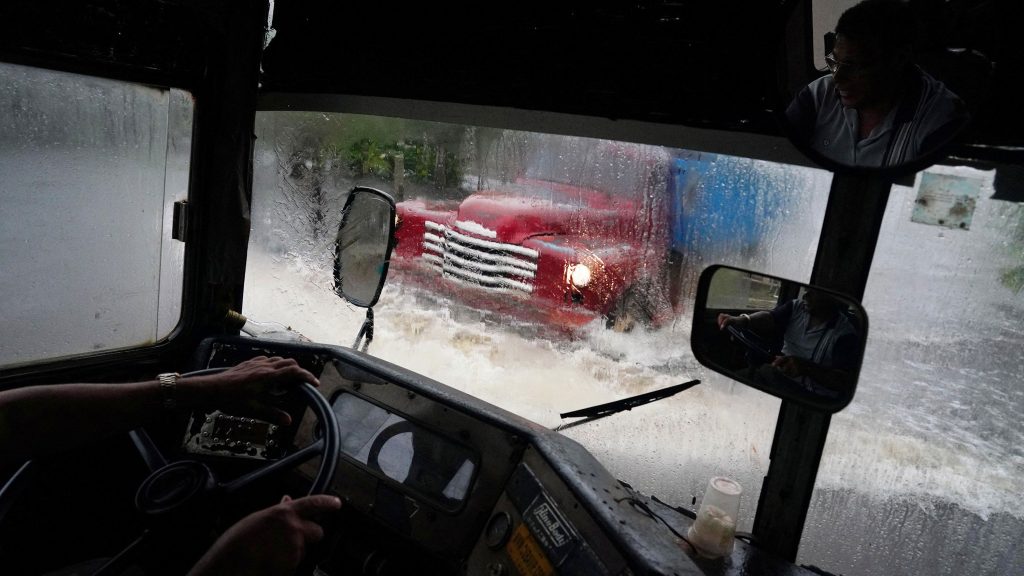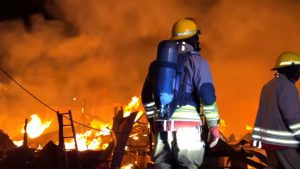
(CNN) — Idalia strengthened into a Category 2 hurricane with 100 mph winds as it lashes Florida ahead of a potentially catastrophic collision with the state’s west coast.
Conditions are already deteriorating as water levels rise on the coast and outer storm bands from the hurricane, which stretch miles from its core, rake across the southern part of the peninsula.
The storm’s impacts will only increase in the coming hours as a Category 3 landfall Wednesday morning draws nearer, bringing once-in-a-lifetime hurricane strength and storm surge to parts of the state’s Gulf Coast.
Florida officials have already told some people to flee, closed schools and shuttered a major airport in preparation for the storm’s impact.
The hurricane is expected to hit as a Category 3, bringing powerful winds and a potential storm surge of 10 to 15 feet to the Big Bend area. That would stack a wall of seawater halfway up the second floor of an average building.
The Tampa Bay area could see storm surge of 4 to 7 feet. Anything greater than four feet of storm surge inundation in the Tampa Bay area would set a new record there. Six feet of surge inundation would set a record in Cedar Key on the southern side of the Big Bend.
While other storms, like Hurricane Ian, have produced higher storm surge, these levels would be unprecedented for this part of the Florida Gulf Coast.
Idalia may also bust precedent as the first major hurricane in at least 172 years to track into Apalachee Bay in the sparsely populated Big Bend region, according to the National Hurricane Centre and its Tallahassee office.
“Don’t mess with this one,” the office said.
While the center of the hurricane isn’t expected to make landfall in the Tampa area, any wobble or shift in its track over the next 12 hours dramatically increases the region’s surge levels, which are already forecast to be dangerous.
Urban search and rescue teams are on standby from the Federal Emergency Management Agency, while the Army Corps of Engineers is set to support power generation missions, FEMA Administrator Deanne Criswell told “CNN This Morning” on Tuesday.
Beware of flood risk and heed evacuation orders, she advised, noting, “The No. 1 killer in all of these storms is water, whether it’s the storm surge that’s going to happen at the coast or the excessive rainfall that might happen inland that causes urban flash flooding.”
State and local officials reminded residents they often don’t have to go far – tens of miles, versus hundreds – to get to a safer place.
“You do not have to leave the state,” Florida Gov. DeSantis said Tuesday. “Get to higher ground in a safe structure. You can ride the storm out there and go back to your home.”
Before landfall, Idalia could produce a few tornadoes Tuesday along the west central Florida coast and by Tuesday night northward into the Big Bend.
Storm surge – when a storm’s winds push the ocean onshore – could force water to rise up to 15 feet in parts of northern Florida, with “the deepest water … along the immediate coast in areas of onshore winds, where the surge will be accompanied by large and dangerous waves,” the hurricane center warned.
Heavy rain could produce flash flooding Tuesday into Wednesday across portions of Florida’s west coast and panhandle and southern Georgia, spreading Wednesday into Thursday into portions of the eastern Carolinas. Four to 8 inches of rain could fall from Tuesday to Thursday in those places, flooding streets.
“Everybody on that Gulf Coast from Tampa Bay up until Northwest Florida must remain vigilant,” DeSantis said.
Idalia at 2 p.m. Tuesday was a Category 1 storm, with maximum sustained winds of 90 mph, heading north at 15 mph about 240 miles south-southwest of Tampa, the hurricane center said.
As the storm makes its way to Florida, preparations could be seen across the state. Here’s the latest:
• Evacuations in at least 22 counties: Baker, Citrus, Dixie, Franklin, Gilchrist, Gulf, Hernando, Hillsborough, Jefferson, Lafayette, Levy, Madison, Manatee, Marion, Pasco, Pinellas, Sarasota, Suwannee, Taylor, Union, Volusia and Wakulla counties have all issued evacuation orders, some mandatory. State tolls are waived in Citrus, Hernando, Hillsborough, Lake, Pasco, Pinellas and Sumter counties, DeSantis said Tuesday.
• Air and train travel halted: Major airlines have canceled hundreds of flights as Tampa International Airport suspended commercial operations Tuesday and St. Pete-Clearwater International Airport Terminal building is set to close Tuesday afternoon. Amtrak has canceled at least 12 East Coast routes and is modifying others.
• Schools close: 42 school districts have announced closures over the next two days, along with 16 state colleges and seven universities, DeSantis said Tuesday.
• Emergencies declared: DeSantis expanded an emergency declaration to 49 of 67 Florida counties on Monday morning. Several local jurisdictions have also declared emergencies. North Carolina and Georgia have also declared states of emergency.
• National Guard activated: More than 5,500 Guard members have been activated for storm response. Florida officials also activated eight search and rescue teams and stationed over 580 rescue personnel to help, officials said Tuesday. Texas Gov. Greg Abbott has also deployed search and rescue teams to assist with disaster response in Florida.
• US Navy ships begin leaving: Navy ships have begun leaving Florida ahead of Idalia’s landfall, the Navy said Monday.
• Power outages expected: DeSantis told residents to prepare to be without power. “If you are in the path of the storm, you should expect power outages so please prepare for that,” the governor told residents Sunday.
• Hospital system suspending services: Patients will be transferred from at least three hospitals: HCA Florida Pasadena Hospital, HCA Florida Trinity West Hospital and HCA Florida West Tampa Hospital.
“We want everyone to take this storm seriously,” Barbara Tripp, Tampa’s Fire Rescue Chief said during a news conference, adding residents also should clear debris from property and look out for neighbors who may need help.
“Once the wind reaches a certain miles per hour, Tampa Fire Rescue will not be able to respond,” Tripp warned.
With the storm forecast to strengthen quickly as it tracks through the Gulf of Mexico, it’ll be tapping into some of the warmest waters on the planet ahead of making landfall in Florida. If it does, it would join a growing list of devastating storms like monster Hurricane Ian – which leveled coastal Florida and left more than 100 dead – to rapidly intensify before landfall in recent years.
Idalia posed a “notable risk” of this phenomenon, the National Hurricane Center warned Monday, as it travels through the Gulf of Mexico.
Water temperatures around southern Florida climbed to 100 degrees Fahrenheit in some areas this summer, and temperatures in the Gulf overall have been record-warm, with more than enough heat to support rapid strengthening.
Storm surge will be ‘life-threatening’
Deadly storm surge up to 12 feet is possible in Florida’s Big Bend, a danger that only will be worsened by waves fueled by hurricane-force winds stronger than 100 mph. Storm surge accounts for nearly half of all hurricane-related fatalities, the National Oceanic and Atmospheric Administration says, and is the reason behind most storm evacuations.
Cedar Key could be cut off by the high storm surge, National Hurricane Center Deputy Director Jamie Rhome said.
“I’m especially concerned for them,” Rhome said during a briefing on Facebook Live. “If you’re watching from Cedar Key, it is imperative that you take this very seriously and if ordered to evacuate, heed those evacuations immediately. The entire island could be completely cut off with conditions like that.”
Evacuation orders along the coast are in place because of the projected storm surge, Rhome stressed.
Inland areas also could see hazardous flooding and heavy rainfall from Idalia. Heavy rainfall-related hazards can also occur as far as 100 miles away from where the storm center tracks, warned Andrew Kruczkiewicz, senior researcher at the Columbia University’s Climate School.
“This is something that we’re seeing more and more, and this is a climate change connection because we’re seeing wetter tropical cyclones and wetter hurricanes,” he told CNN. “So, we need to pay more attention to the risks associated with intense precipitation, especially in areas that are distant from the coastline.”
Officials on Tuesday reminded residents under evacuation orders they “don’t have to evacuate hundreds of miles.”
“We are talking tens of miles. Just get to higher ground, get to a friend’s house, get to a hotel, get to a shelter,” said Brian Aungst, mayor of Clearwater in Pinellas County, parts of which are under a mandatory evacuation order.
Those who don’t heed orders to leave should shelter in place, said Police Chief Anthony Holloway of St. Petersburg, where some residents are advised to leave.
“You are going to be on your own until the weather dies down, and then we will be able to come back out and rescue you,” he said.





More Stories
BNA responds to incident at Netball Stadium
Support continues for families displaced by fire
Farmers get advice on boosting milk production